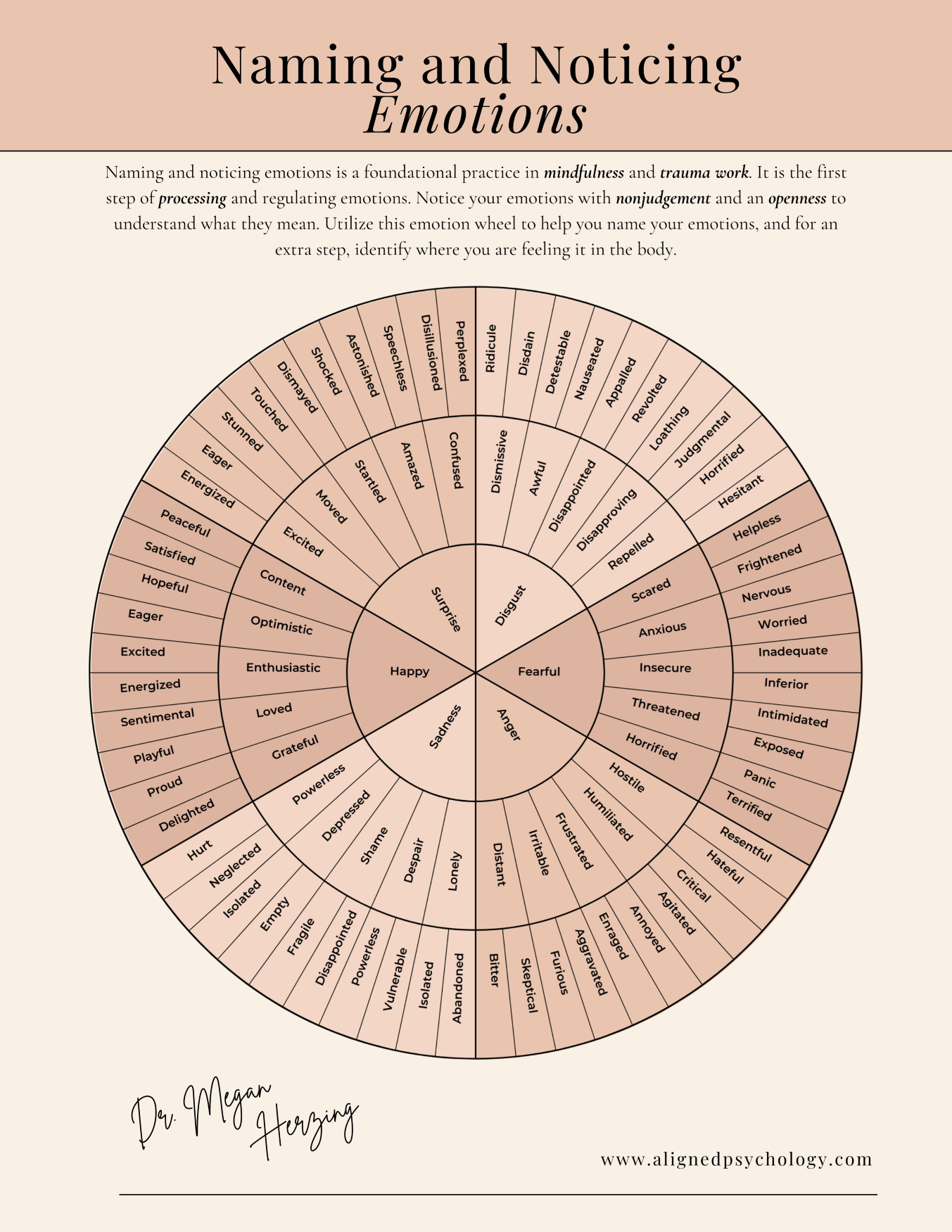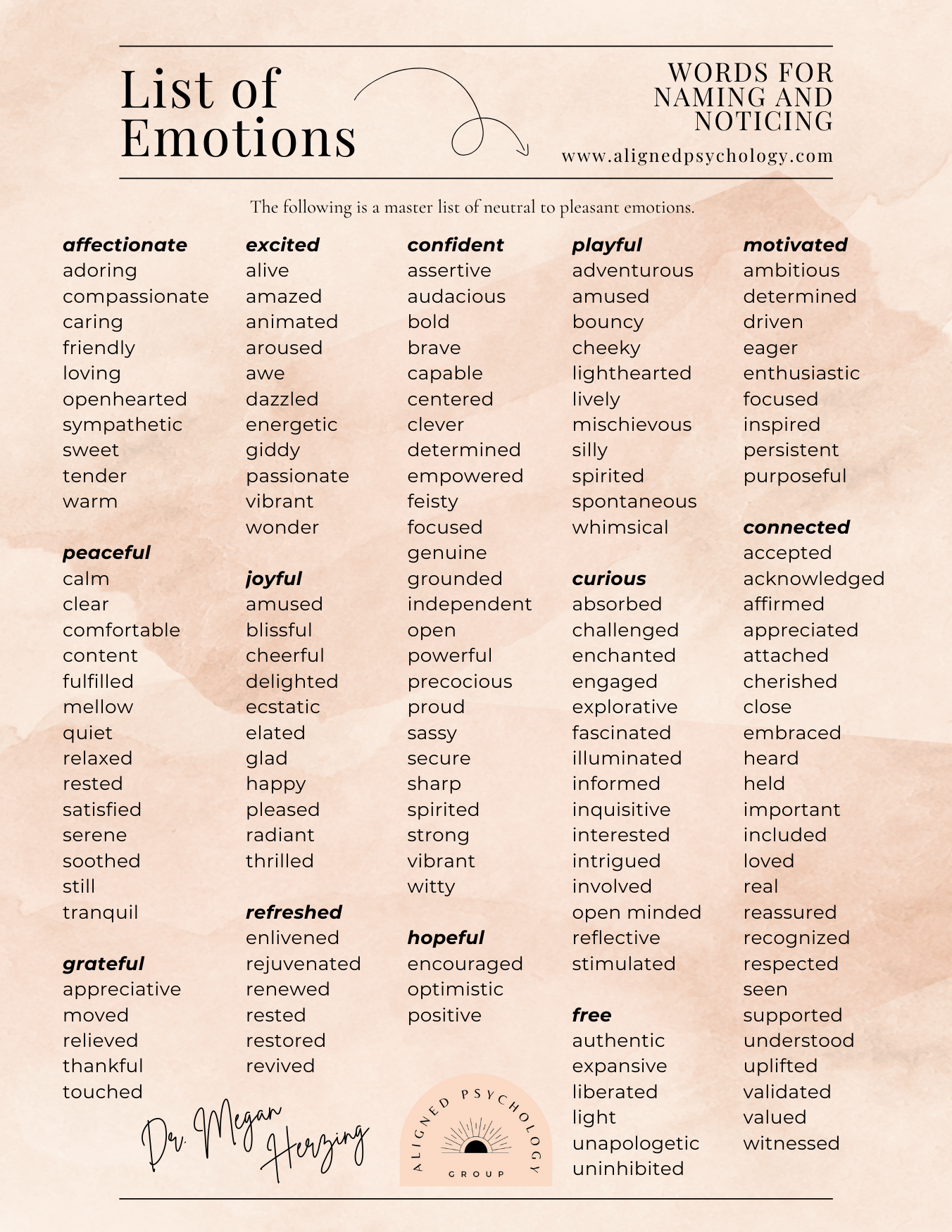Trauma Therapy Homework - Week 1
Week 1: (The Basics)
Naming and Noticing Emotions
Starting trauma therapy can feel like stepping into uncharted territory. It’s brave, and it’s also deeply personal. To help you navigate this journey, your therapist may give you "homework" to practice outside of sessions. Think of this as an opportunity to build new skills, strengthen your emotional resilience, and gain insights into yourself. This week, we’re starting with a foundational practice: Naming and Noticing Emotions.
Why is this important? Naming emotions is the first step toward emotional processing and regulation. It’s like learning a new language—the language of your inner world. When you can identify and name your feelings, you begin to take charge of your emotional experience rather than feeling overwhelmed or disconnected. Let’s dive into the how and why of this practice.

What Does It Mean to Name and Notice Emotions?
Naming emotions is simply putting words to what you’re feeling. This might sound straightforward, but for many of us, it’s surprisingly challenging. Sometimes, emotions show up as vague discomfort, tension, or unease in the body, and we don’t always know what to call them. By learning to notice these feelings and give them a name, you create clarity and start to understand yourself better.
For example:
Instead of saying, “I feel bad,” you might notice, “I feel anxious and a little sad.”
Instead of saying, “I’m upset,” you might identify, “I’m feeling frustrated and overwhelmed.”
The act of naming helps bring your emotions into focus, making them feel less chaotic and more manageable.
Where Emotions are Felt in the Body
Emotions don’t just exist in your mind; they’re also felt in your body. For example:
Anxiety might feel like a tightness in your chest or a fluttering in your stomach. Anger might show up as heat in your face or tension in your jaw. Sadness might feel like heaviness in your shoulders or a lump in your throat. Paying attention to where emotions live in your body is a key part of this practice. It helps you tune into your experience and creates a bridge between your physical sensations and your emotional awareness.
The Wheel of Emotions
One of the most helpful tools for naming emotions is the Wheel of Emotions, created by psychologist Robert Plutchik. This visual tool organizes emotions into core categories (like joy, anger, sadness, and fear) and then expands them into more specific feelings. For example:
“Joy” might branch into “pride,” “excitement,” or “relief.”
“Fear” might expand into “anxiety,” “worry,” or “dread.”
The Wheel of Emotions is a great way to find the right words for what you’re feeling. Keep a copy on hand—you can even print it out or save it to your phone—and refer to it when you’re trying to pinpoint an emotion.
Why This Practice Matters
Naming and noticing emotions is the foundation for emotional processing and regulation. Here’s why it’s so important:
1. It Reduces Emotional Overwhelm
When emotions are left unnamed, they can feel big and overwhelming. Naming them gives you a sense of control and makes them feel more manageable.
2. It Enhances Self-Awareness
Understanding your emotions helps you understand yourself. It’s a key part of building a deeper connection with your thoughts, feelings, and needs.
3. It Improves Emotional Regulation
Once you can identify what you’re feeling, you’re better equipped to respond to your emotions in healthy ways. For example, if you notice you’re feeling anxious, you can use grounding techniques to calm your nervous system.
4. It Strengthens Relationships
Being able to name and express your emotions helps you communicate more effectively with others. This can lead to greater understanding and stronger connections.


Common Challenges and How to Overcome Them
If this practice feels hard at first, you’re not alone. Here are some common challenges and tips to work through them:
1. “I Don’t Know What I’m Feeling”
Start with the basics. Ask yourself, “Do I feel good or bad right now?” Then use the Wheel of Emotions to narrow it down. It’s okay if it takes time to get specific.
2. “I Feel Too Much at Once”
It’s normal to feel multiple emotions at the same time. Try naming them all: “I feel both anxious and excited about this new opportunity.”
3. “I’m Afraid to Feel My Emotions”
This is a common response, especially if you’ve experienced trauma. Remind yourself that emotions are temporary and that naming them doesn’t mean you’ll be overwhelmed by them. Start with small, manageable feelings and build from there.
Tools to Support Your Practice
Here are a few additional tools and strategies to help you:
Emotion Cards: These are decks of cards with different emotions and descriptions. They can be a great resource for identifying feelings.
Body Scans: Guided meditations that help you tune into your physical sensations and connect them to emotions.
Apps:
Apps like MoodMeter or Daylio can help you track your emotions and notice patterns over time.
Wheel of Emotions: Screen shot the wheel of distressing emotions below and use it as a reference.
List of Emotions: Screen shot the lists of distressing and pleasant emotions below for reference.
A Final Note
Naming and noticing emotions is a simple yet profound practice. It’s the first step toward understanding yourself and creating a sense of emotional balance. As you practice this skill, remember to be patient and kind with yourself. Healing is a journey, and every step you take—no matter how small—is meaningful. By starting here, you’re laying the groundwork for deeper emotional processing and regulation in the weeks to come. You’re building a toolkit that will support you not just in therapy but in life. Keep practicing, stay curious, and trust the process—you’re doing incredible work.
FREE Downloadable Handouts
Click this
LINK
for free access to downloadable PDFs from the Trauma Therapy Homework Series. You’ll be directed to my Google Drive folder, where you can explore all the handouts created so far. You can choose between a digital format for easy viewing on your device or a printable version if you prefer a hard copy.
Here is a preview of this week's handout! Click the link above to get your own free pdf copy.




ABOUT THE AUTHOR
Dr. Megan
Megan Herzing PsyD, Licensed Professional Clinical Counselor, specializes in trauma therapy and creating a safe, supportive space for healing. She integrates evidence-based modalities, including EMDR, Internal Family Systems (IFS), somatic therapy, and Emotionally Focused Therapy (EFT), to address the mind-body connection and empower clients on their journey to wellness. With extensive experience treating complex PTSD, anxiety, attachment injuries, and dissociation, she believes in the power of self-compassion and authentic connection to facilitate lasting change. Drawing from her own healing journey, she brings empathy and lived experience to her work, honoring each client’s unique path toward growth and resilience.
Thank you for being part of a community of humans that deeply cares about healing.
We are honored that you stopped by and hope our resources will continue to bring value to your life.
We are accepting new clients in California, and referrals are always appreciated.












